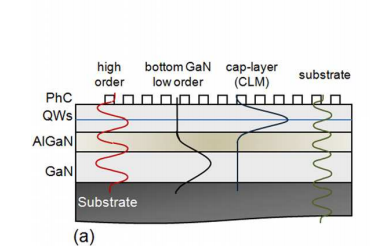The enhancement of the extraction effificiency in light emitting diodes (LEDs) through the use of photonic crystals (PhCs) requires a structure design that optimizes the interaction of the guided modes with the PhCs. The main optimization parameters are related to the vertical structure of the LED, such as the thickness of layers, depth of the PhCs, position of the quantum wells as well as the PhC period and fifill factor. We review the impact of the vertical design of different approaches of PhC LEDs through a theoretical and experimental standpoint, assessing quantitatively the competing mechanisms that act over each guided mode.
Three approaches are described to overcome the main limitation of LEDs with surface PhCs, i.e. the insuffificient interaction of low order guided modes with the PhCs. The introduction of an AlGaN confifining layer in such structure is shown to be effective in extracting a fraction of the optical energy of low order modes; however, this approach is limited by the growth of the lattice mismatched AlGaN layer on GaN. The second approach, based on thin-fifilm LEDs with PhCs, is limited by the presence of an absorbing reflflective metal layer close to the guided modes that plays a major role in the competition between PhC extraction and metal dissipation. Finally, we demonstrate both experimentally and theoretically the superior extraction of the guided light in embedded PhC LEDs due to the higher interaction between all optical modes and the PhCs, which resulted in a close to unity extraction effificiency for this device.
Among many other designs for light extraction, those relying on PhCs are yielding improved performances. From the beginning, PhCs have been suggested as a way to realize high-effificiency light sources . The early concept of controlling spontaneous light emission by an omnidirectional 3D photonic band gap (PBG) has had limited success in devices due to practical diffificulties, such as achieving highly ordered 3D PhCs and proper positioning of the emitting species within the structure. A more successful approach has been the use of membrane-supported 2D-PhCs, where the PBG of the PhCs inhibits the propagation of the guided modes in the membrane, thus forcing spontaneous emission into radiative modes. Although increased extraction effificiency was convincingly demonstrated in such membranesupported 2D-PhCs, the strong reduction in spontaneous radiative emission rate for photons within the PBG requires one to rely on low temperature (LT) operation to diminish the effect of competing non-radiative recombination and maintain a good IQE.
The effificacy of PhCs in providing superior light extraction and directional light emission in LEDs has been demonstrated by a large body of work. The periodic modulation of the refractive index in PhCs serves as an optical grating to couple guided modes from the semiconductor slab to air, thus increasing the light extraction effificiency of LEDs. In these cases, the 2D-PhCs operate mostly outside the PBG spectral range acting as a diffraction grating placed directly on the light source.

Fig1
The schematics of the LED with AlGaN confifining layer is shown in fifigure 1(a) along with the four different families of guided modes supported in such a structure: high order, low order guided in the bottom GaN layer (called extraction gap), the CLM, guided in the top GaN layer and the substrate modes, extending over the thick substrate slab.
While the AlGaN layer does not modify signifificantly the profifile of the high order and substrate modes, the low order modes are now mostly confifined either in the top or in the bottom GaN layer. The CLM, confifined in the top GaN layer, interacts better with the PhCs and has a higher optical excitation by the QWs, whereas the modes confifined in the bottom GaN layer are neither well extracted nor excited due to their poor interaction with both the PhCs and the QWs. Therefore, the AlGaN layer redistributes the optical energy of the low order modes, exciting more the CLM, which has the shortest extraction length among this family of modes, and not exciting the poorly extracted modes.
When an Al0.16Ga0.84N confifining layer is introduced in the structure, the energy of the guided modes is redistributed, and a change in behaviour in both excitation and, as we show later, in extraction length (figure 4) occurs for modes with neffective > 2.32, which we designate low order modes (grey region in figure 2(a)). While the high order modes (neffective < 2.32) are not modifified, some low order modes are less excited and their energy is redirected to the CLM. The energy of all the low order modes in the LED without AlGaN corresponds to 41%, representing a signifificant fraction of the total guided light that is poorly extracted by the PhCs. Part of this energy is used to excite the CLM when the Al0.16Ga0.84N confifining layer is introduced in the structure. For a 300 nm thick Al0.16Ga0.84N layer, the CLM receives 9.3% of the guided energy emitted by the QWs; however, this mode is not completely confifined in the cap layer, as shown in fifigure 2(b). The CLM confifinement in the cap layer is increased with a 600 nm thick Al0.16Ga0.84N layer (fifigure 2(b)) and so is its excitation by the QWs (14.8% of the optical guided energy).
下一篇: 高功率LED封装及应用中的热量和流体流动